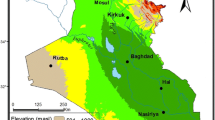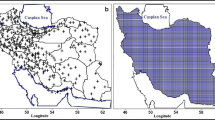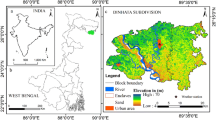Abstract
The present study tends to describe the survey of climatic changes in the case of the eastern and central areas of Iran and, to some extent, the northern parts. The monthly and yearly change trends in the minimum, maximum and mean temperatures, relative humidity, and the precipitation were surveyed for 26 synoptic stations in Iran during a 55-year period. The study was carried out by using the τ-Kendall test. The results showed the same temperature changes for the centrally located stations as the eastern and northern ones. Most of the stations in Zagros showed no significant temperature changes. A significant decrease in the precipitation was seen in summer in different stations. Most of the eastern and centrally located stations showed a decrease in relative humidity trend, while this condition was not recorded in Zagros and northern part of Iran. The present results also showed that the upward trend of minimum air temperature had an effect in increasing the mean air temperature in the stations with temperature ascending trend. This effect of minimum temperature was significantly more than that of the maximum temperature, which could be the result of increasing the amount of greenhouse gases and the reflection of received thermal energies, from land through the night. This increase in the temperature and a decrease in relative humidity would cause an increase in the evaporation of the received precipitation.







Similar content being viewed by others
References
Abahussain AA, Abdu AS, Al-Zubari WK, El-Deen NA, Raheen MA (2002) Desertification, in the Arab region: analysis of current status and trends. J Arid Environ 51:521–545
Brutsaert W, Parlange MB (1998) Hydrologic cycle explains the evaporation paradox. Nature 396:30
Chmielewski FM, Rötzer T (2002) Annual and spatial variability of the beginning of growing season in Europe in relation to air temperature changes. Clim Res 16:257–264
Elagib NA, Abdu SA (1997) Climate variability and aridity in Bahrain. J Arid Environ 36:405–419
Evans J, Geerken R (2004) Discrimination between climate and human-induced dryland degradation. J Arid Environ 57:535–554
Florides GA, Christodoulides P (2008) Global warming and carbon dioxide through sciences. Environ Int 35(2):390–401
Grundstein A (2009) Evaluation of climate change over the continental United States using a moisture index. Clim Change 93:103–115
Kendall MG, Stuart A (1973) The advanced theory by statistics. Griffin, London
Kousari MR, Asadi Zarch MA (2010) Minimum, maximum, and mean annual temperatures, relative humidity, and precipitation trends in arid and semi-arid regions of Iran. Arab J Geosci. doi:10.1007/s12517-009-0113-6
Modarres R, Sarhadi A (2009) Rainfall trends analysis of Iran in the last half of the twentieth century. J Geophys Res 114:D03101
Modarres R, Silva VdPRd (2007) Rainfall trends in arid and semi-arid regions of Iran. J Arid Environ 70:344–355
Ragab R, Prudhomme C (2002) Climate change and water resources management in arid and semi-arid regions: prospective and challenges for the 21st century. Biosyst Eng 81:3–34
Sadeghi AR, Kamgar-Haghighi AA, Sepaskahah AR, Khalili D, Zand-Parsa S (2002) Regional classification for dryland agriculture in southern Iran. J Arid Environ 50:333–341
Valdez-Cepeda RD, Hernández-Ramírez D, Mendoza B, Valdés-Galicia J, Maravilla D (2003) Fractality of monthly extreme minimum temperature. Fractals 11:137–144
Wang HL et al (2008) Phenological trends in winter wheat and spring cotton in response to climate changes in northwest China. Agri Forest Meteor 148(8–9):1242–1251
Zhenmei M, Kang S, Zhang L, Tong L, Xiaoling S (2008) Analysis of impacts of climate variability and human activity on stream flow for a river basin in arid region of northwest China. J Hydrol 352(3–4):239–249
Acknowledgments
The authors acknowledge the efforts of the Desert Region Research Institute, University of Yazd, Yazd, Iran for supporting the present work.
Author information
Authors and Affiliations
Corresponding author
Rights and permissions
About this article
Cite this article
Kousari, M.R., Ekhtesasi, M.R., Tazeh, M. et al. An investigation of the Iranian climatic changes by considering the precipitation, temperature, and relative humidity parameters. Theor Appl Climatol 103, 321–335 (2011). https://doi.org/10.1007/s00704-010-0304-9
Received:
Accepted:
Published:
Issue Date:
DOI: https://doi.org/10.1007/s00704-010-0304-9




